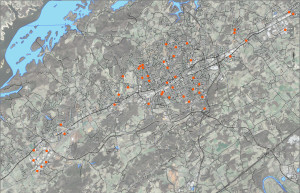Wastewater collection systems are underground and out of sight. However, when a sewer rehabilitation project accounts for nearly one-third of a city’s wastewater system, it affects the community in a big way. LDA Engineering recently assisted Morristown Utilities Commission with the rehabilitation of the Spring Creek basin, much to the city’s benefit.
LDA Engineering was presented with two significant issues, and our task was to find creative solutions.
Issue: The Tennessee Department of Environment and Conservation issued a Commissioner’s Order to the City of Morristown to rehabilitate multiple sewer sheds. The sewer collection system consists of approximately 1.3 million feet of pipe and 28 pump stations. Sewer sheds are large sewer collection systems that flows into a sewer pump station.
 Solution: LDA Engineering divided the sewer collection system into 28 unique mini-systems, as well as four gravity sewer sheds flowing to a main sewer pump station, which convey the sewer flow via force mains and sewer interceptor to the wastewater treatment plant. Following a hydraulic model assessment and a sewer system evaluation survey (SSES), the basins were prioritized by need, and LDA Engineering commenced with design.
Solution: LDA Engineering divided the sewer collection system into 28 unique mini-systems, as well as four gravity sewer sheds flowing to a main sewer pump station, which convey the sewer flow via force mains and sewer interceptor to the wastewater treatment plant. Following a hydraulic model assessment and a sewer system evaluation survey (SSES), the basins were prioritized by need, and LDA Engineering commenced with design.
Issue: The first priority project was the sewer rehabilitation of the Spring Creek basin. The project involved the rehabilitation of a 15-inch gravity sewer line adjacent to Stubblefield Creek that passed narrowly under a warehouse with foundation considerations to a manhole located inside the fully functioning structure.
Solution: Horizontal drilling was used to replace the 15-inch gravity sewer pipe with a new 16-inch HDPE pipe. LDA Engineering used pipe bursting, cured-in-place, “dig and lay” replacement and manhole rehabilitation as techniques to ensure the project’s success.
The Spring Creek rehabilitation activities were divided into several phases to expedite construction, and the sewer shed was split into three sub-basins. Construction first began on the upper two basins. The third basin will be rehabilitated when post-construction flow monitoring data can be processed from the first two basins rehabilitation construction activities. By phasing construction this way, LDA Engineering and Morristown Utilities Commission will be able to more accurately determine the rehabilitation efforts of the remaining section.
With adaptable solutions, LDA Engineering, the Morristown Utilities Commission, and the City of Morristown were able to solve the problem in the first two basins within the Spring Creek sewer shed. Sewer rehabilitation design and construction activities continue on other sewer sheds throughout the City. By thinking critically and constantly monitoring construction, we’re confident the team will complete the additional projects on time.
